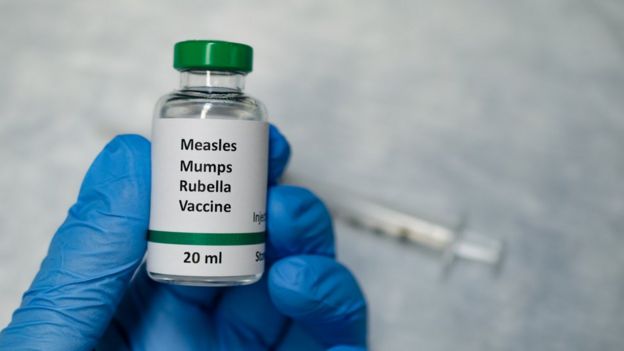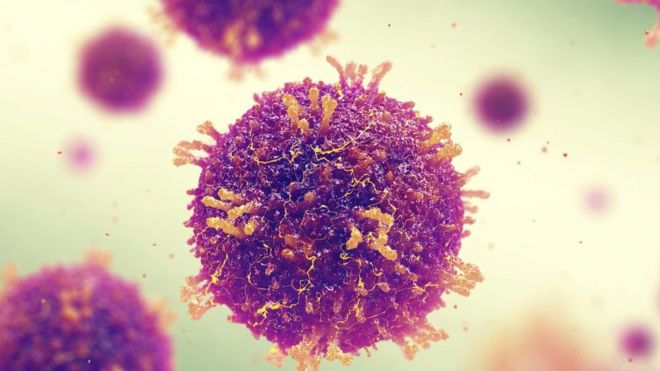A few days later it leads to a blotchy rash that starts off on the face and spreads across the body.
Most people will recover, but measles can cause life-long disability. It can be deadly, especially if it causes pneumonia in the lungs or encephalitis (swelling in the brain).
It is estimated that 110,000 people die from measles each year around the world.

A rash is the most obvious symptom of a measles infection / GETTY IMAGES
Where do these findings come from?
The findings were based on detailed analysis of unvaccinated children in an Orthodox Protestant community in the Netherlands.
Blood samples were taken from the children, and then again two months after a measles outbreak in 2013.
Research groups in the United States, UK and Netherlands were analysing the samples to assess the impact of measles on the immune system.
The focus was on antibodies - the tiny proteins that stick to foreign invaders - and the white blood cells that make them.
How does measles wipe out immune memory?
The immune system has a memory of the hostile invaders it has fought off before.
Part of this memory is kept in memory B-cells, which are a type of immune cell that has specialised in producing just one type of antibody.
But the measles virus can infect and destroy these cells, causing "immune amnesia".
Researchers at Harvard Medical School looked at blood samples from 77 children.
They used a tool, called VirScan, that is like a fancy fishing rod that can catch thousands of different types of antibodies.
It allowed the team to build up an incredibly detailed picture of the children's immune system before and after a measles infection.

Antibodies are tiny Y-shaped proteins that can stick to the surface of bacteria and viruses / GETTY IMAGES
Results, published in the journal Science, showed the children lost 20% of their repertoire of antibodies on average.
One child, who had a severe measles infections, lost 73% of the types of antibody they could produce.
"Measles is like the first 10 years of an untreated HIV infection compressed into a few weeks - that's the kind of immunological memory damage," Dr Michael Mina told the BBC.
How big a problem is this?
Not every antibody matters.
An antibody might be one (of the huge number) that do very little, but another might completely neutralise a microscopic intruder.
"If you delete that one then you've got a problem," Prof Stephen Elledge told the BBC.
Essentially, it is a game of chance but the more antibodies that get wiped out, the greater the chance of hitting a crucial one.
And without it, your body may be vulnerable to infection once again.
This was borne out in the study with one particularly well-known antibody (for neutralising respiratory syncytial virus) disappearing in some children.
Prof Elledge said measles was even more dangerous than people realised, as there could be "five times or more indirect deaths due to immune amnesia" than the initial infection caused.
The researchers think the biggest problem is in sub-Saharan Africa where malnourished children are more likely to have larger swathes of their immune system wiped out.
The studies have not been done to prove this, but the US team fear the figure could exceed 90% of the antibodies.
"Those are the ones we think are the greatest concern," said Dr Mina.
How does measles make it harder to fight new infections?
As well as memory B-cells there are naive B-cells and it is the latter we rely on to fight off something new.
"They are the armour underneath," said Dr Velislava Petrova, from the Sanger Institute said.
Her study, published in Science Immunology, looked at 26 children and also showed that measles can wipe out the memory of previous infections.
But the research also showed the virus had an effect on the naive B-cells too.
These cells have their DNA rearranged - a process called somatic recombination - so the immune system can produce a diverse array of back-up antibodies.
The hope is one of them will work against a new infection.

GETTY IMAGES
Babies start off making a very narrow range of antibodies, which become more and more varied with age.
Measles hits the reset button so the immune system only has a limited range of antibodies to work with.
Dr Petrova said: "The measles virus removed immune memory cells that are created in response to other pathogens they had seen before.
"They also returned the immune system back to a baby-like state where they have limited ability to respond to new pathogens."
How long do these effects last?
The pair of studies focused only on the immediate aftermath of a measles infection.
However, the research was partially inspired by a study that came out in 2015, which provides some clues to what happens in the long term.
It looked at patterns in causes of death in rich countries and showed that children were more likely to die for two-to-three years after a measles infection.
Those results suggest it may take that long for the immune system to fully recover.
The timescales may be different in poorer countries where diseases spread more readily, the researchers suggest.
Is there anything that can be done about it?
There are two answers to this question, and they are both vaccination.
Being immunised against measles, often through the MMR jab, almost eliminates the risk of catching measles.
But if somebody's immune system is devastated by measles then the researchers suggest they may need to have their childhood vaccines again.
"Revaccination against polio might not seem important in the UK or US, but in Afghanistan (one of the few places where the disease is still endemic) then you might want to vaccinate again," said Dr Mina.

GETTY IMAGES
Are there other forms of immune memory?
Yes.
The study looked only at antibodies and the B-cells that produce them, but there are also equally important memory T-cells.
Measles can infected these T-cells too, but the studies have not yet been done on what happens to them.
"We do have really interesting anecdotal evidence suggesting the T-cell response would be affected in a very similar way," said Dr Mina.
What do the experts say?
Prof Arne Akbar, president of the British Society for Immunology, said the studies were "elegant and thorough".
He highlighted the "crucial" finding that the MMR vaccine, which contains a weakened measles virus, did not cause immune amnesia.
"It is doubly important to make sure you and your children are vaccinated against measles," he said.
Liam Sollis, from Unicef UK, said: "With vaccination rates in the UK falling and recently losing our measles-free status, an outbreak is now a ticking time bomb.
"Vaccines are the safest and most effective preventative measures against highly infectious disease."




